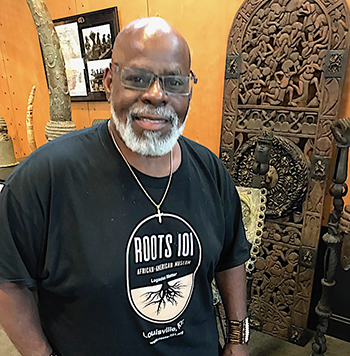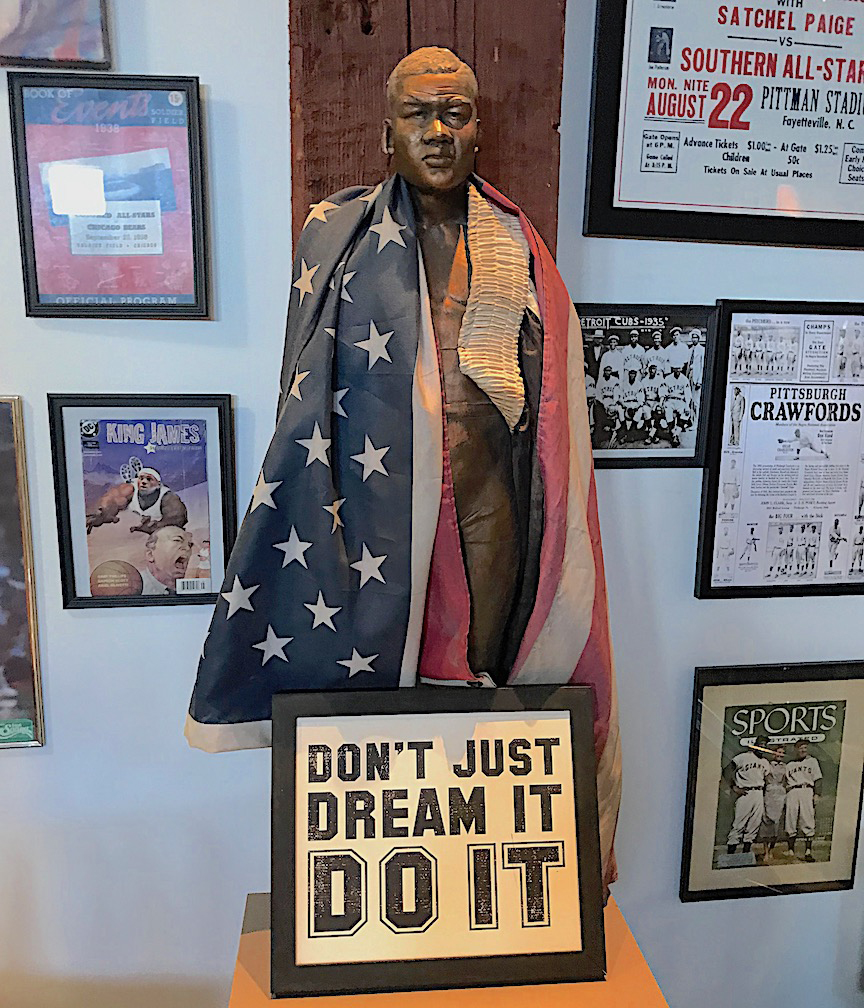| |
Roots 101: A museum that really makes you think
By Tom Adkinson
September 2, 2022

The reality of slave shackles is one of the first lessons you learn at the Roots 101 African American Museum. Image by Tom Adkinson
|
| |

Museum founder and CEO Lamont Collins calls Roots 101 a healing place where reality is recognized. Image by Tom Adkinson |
| |
|
LOUISVILLE, Kentucky -- Think of Roots 101 as the introductory college course that can last a lifetime. That’s the idea that drove Lamont Collins to establish the Roots 101 African American Museum.
The educational experience of Roots 101 begins just inside the door. A docent asks you to hold your arms out and with your permission, of course, slips shackles over your wrists. Your first reaction is to exclaim about how heavy they are and then to stretch our arms apart to see how far the links of the chain extend. Not far.
They are slave shackles, but the startling message comes next.
“Those actually are leg shackles. Arm shackles have shorter chains, as you’ll see deeper in the museum,” the docent tells me.
The rest of the museum is a continuing series of illuminating experiences and galleries dealing with the realities of the Black experience in America. Many are somber, but many are joyful and uplifting, too.
Throughout two levels of artifacts covering everything from Blacks’ heritage in Africa and the horrors of slavery to Jim Crow, Motown and the death of Breonna Taylor, the story Collins wants to convey is of Blacks’ historical reality, talent, success and perseverance.

The main gallery at Roots 101, Faces of Africa, features African art from several countries. Image by Tom Adkinson
|
The first gallery, Faces of Africa, is resplendent with African art – bronze leopards from Benin, ceremonial masks from Nigeria, regal portraits and more.
“We are descendants of kings and queens, not just slaves,” Collins says to explain the caliber and intricacy of the artwork, adding that everything in the collection is accessible to be touched and felt.
“Roots 101 is an open-heart story. This is a healing space. If we treat the wounds, we get better,” Collins says, noting that people of all descriptions can grow.
“If the comfortable stay comfortable, they don’t learn,” he says.

This station of champion boxer Joe Louis is part of the Great Equalizer exhibit about Blacks’ difficult entry into professional sports. Image by Tom Adkinson
|
Collins says that he began collecting items when he was a child and that many people have donated artifacts and art after the museum took shape.
“I got into history when I was 10 or 12 years old. I was dropped behind enemy lines when my parents moved into a white neighborhood,” he says.
A particularly uplifting gallery is “Big Momma’s House,” a room absolutely filled with portraits, diplomas and family artifacts. The explanation is that “every Black family has a Big Momma or a matriarch whose house is filled with family history and achievements.” Every Big Momma’s house became a crucial part of a family’s culture.

The Protest to Progress gallery touches on many events in Black history, including the death of Breonna Taylor. Image by Tom Adkinson
|
Roots 101 opened in 2019, and its collection earned accolades from Architectural Digest, which included it in a 2020 list of new museums of special note. Among others that year were the Grand Egyptian Museum in Giza, the Academy Museum of Motion Pictures in Los Angeles and the National Children’s Museum in Washington, D.C.
If Collins was a college professor and Roots 101 was his lecture hall, his students would hear one of his foundational statements about Blacks’ contributions to America: “We were jackhammers before there were jackhammers. We were bulldozers before there were bulldozers. We were engineers before there were engineering degrees.”
Trip-planning resources: Roots-101.org and GoToLouisville.com (The museum is downtown near landmarks such as the Muhammad Ali Center, the Galt House Hotel and Whiskey Row.)
(Travel writer Tom Adkinson’s book, 100 Things To Do in Nashville Before You Die, is available on Amazon.com.
|



